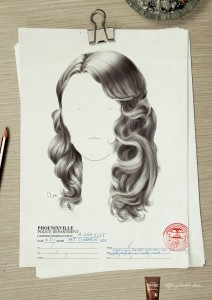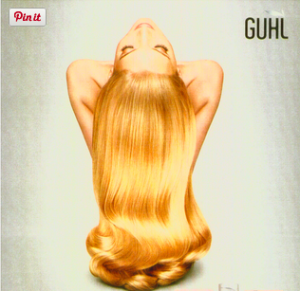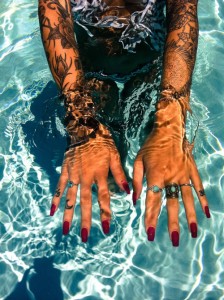My piece entitled ‘Stepping Stones’ is a nostalgic piece that is a reflection on my childhood memories and struggles with growing up. I am a very traditional person, I love following and keeping traditions. Recently I have noticed the extremes I go to recreate these events exactly as they occurred the 1st time. I struggle to let go of these events and accept the fact that they will never be repeated in the same way I experienced them in the 1st time. Each element of the piece represents a different aspect of my story. The photos contain my 1st and favorite teddy bear, Winnie. One image is a close up of me holding the bear to my face, this represents the importance and prominence that Winnie had in my life. Winnie was always number 1 on my list of things to take with me if my house caught on fire. He was a part of me and my identity and I have represented this by composing the photo with the bears face making up half of my face. The next photo is of me facing Winnie represents my struggles and frustration with outgrowing such childhood toys. The 3rd photo is of me physically taking acting and pushing the bear out of the frame and out of my life. The 1st piece of audio is a recording of a ballerina music box that was passed down from my great aunty to me, a peaceful and calming melody that reminds me of childhood. The 2nd audio piece more up-tempo, it is a recording of my skipping, a rhythmical, paced sound that reminds me of this childhood hobby. The last recording is of a young girl that I babysit singing a nursery rhyme. The text in the piece is a photo of the 1st page of my favorite book as a child, ‘Winnie In The Hundred Acre Wood.’ The 1st video clip shows me tearing a piece of artwork I did as a child. This represents me tearing up my past. The 2nd clip shows me scattering the pieces onto the floor. This represents me letting go and allowing nature to work in its own ways rather then forcing it.
Monthly Archives: March 2015
Blood In The Gutter
Todays guest speaker Liam Ward spoke about editing. He described it as fragmenting clips and piecing them together again like a mosaique. By placing 2 things side by side we create meaning and association. Composing fragments and creating a sequence allows the audience to read into the story. Audiences are automatically searching for meaning and sense in the things they view. We tend not to just accept what we are seeing, we have a desire to create an association between frames that are pieced side by side. I used to fear editing my clips, I didn’t like breaking the shots that I had worked to hard to compose. By cutting and re-piecing clips I was able to create rhythm and movement in the sequence. I found that composing the clips this was more intriguing to audiences then viewing mass chunks of footage. Ward mentioned that editing in conjunction with the way the human mind works, enables us to create magic tricks and games with footage. He made an example using Taylor Swift lyrics. These simple white words on a black page caused our brains to disperse out to images and snippets of Taylor Swift. We hear the song in our heads and recall personal associations and memories we have with song. The bigger the gap of association between the 2 juxtaposed images the harder the audience has to work to draw a connection. This makies it more satisfying as the audience is forced to interpret the piece, it has a higher artistic elements.This reading again tied into what Liam Ward spoke about in class. It deals with perception and the mental blanks our mind automatically fills in order to create a complete and fluid image. I used to always find old school TV`s intriguing, as a young kid I would sit up close to the screen wondering how a collection of red, blue and green lights could create a moving, multicolored image. Our reality consists only of what is right in front of us, our brain assumes that there is an existence outside our familiar surroundings. As Lancaster Dodd said in the film The Master – ‘I’ve never been to the Pyramids have you?… and yet we know that they are there, because learned men have told us so’. This causes me to ask the question, what do we really know? We only know what we are told, we know a pen is a pen because we have been told so. We can identify the colour purple because we have learned what it looks like from a young age but how do we know if our perception of purple is the same as everyone else’s? Maybe my purple looks like your yellow, similarly maybe my idea of the taste of chicken is the same as your idea of the taste of tuna. Films like The Matrix, Inception, The Adjustment Bureau and The Truman Show cause me to question my reality. I used to wonder if I was the main subject in a snow globe, living in my own little bubble, in a synthetic world with extraterrestrials looking down and observing me. I also used to question whether my life was a massive science experiment. An experiment that everyone else was in on and I was the guinea pig, blissfully unaware. The reading also spoke about closure and how the mind fills the gaps. We automatically want to tie and loose ends, maybe that’s why films with typical Hollywood narratives are so commercially successful. They conclude with a happy ending leaving us feeling satisfied and complete with our expectations fulfilled.
Editing is deliberately breaking things – Liam Ward
Todays guest speaker Liam Ward spoke about editing. He described it as fragmenting clips and piecing them together again like a mosaique. By placing 2 things side by side we create meaning and association. Composing fragments and creating a sequence allows the audience to read into the story. Audiences are automatically searching for meaning and sense in the things they view. We tend not to just accept what we are seeing, we have a desire to create an association between frames that are pieced side by side. I used to fear editing my clips, I didn’t like breaking the shots that I had worked to hard to compose. By cutting and re-piecing clips I was able to create rhythm and movement in the sequence. I found that composing the clips this was more intriguing to audiences then viewing mass chunks of footage. Ward mentioned that editing in conjunction with the way the human mind works, enables us to create magic tricks and games with footage. He made an example using Taylor Swift lyrics. These simple white words on a black page caused our brains to disperse out to images and snippets of Taylor Swift. We hear the song in our heads and recall personal associations and memories we have with song. The bigger the gap of association between the 2 juxtaposed images the harder the audience has to work to draw a connection. This makies it more satisfying as the audience is forced to interpret the piece, it has a higher artistic elements.
Life without media exposure –
It’s a hard thing to imagine a life without media exposure. The media influences us in so many ways and infiltrates our daily lives. We consume media intentionally as well as involuntarily in our daily routines. Billboards on bus stops, adverts for films, music playing in shops, the radio in a taxi, these things all effect us and the people we develop into. Media can often educate us and inform us about the world outside our immediate boundaries. It enables us to be more culturally and socially aware of the diversity in life. Without media exposure our lives could be considerably more sheltered. We would not have access to a variety of opinions and perspectives and therefore would be subject to follow the beliefs of the people in our immediate surroundings. This dawned on me in my recent babysitting experience. Upon discussion of Aboriginal dreamtime stories one sibling admitted that these stories scared them, the other sibling then replied that there was nothing to be scared of because Aboriginals don’t exist. I was shocked that these children could be so sheltered and unaware of the world around them, even within their own country. I put it down to the fact that they are living in a typically white, upper middle class suburb with minimal exposure and experience with different cultures. With time im sure these kids will come to learn about different cultures and subcultures within our society but I couldn’t help but wonder what my ideas and beliefs would be like without my 18 years of media exposure. Would I be as sheltered and ignorant as a child?
Avante Garde Vs Popular Cinema
Avante Garde comes from the French language meaning “advance guard”. These are experimental films they are innovative and unique and often contain strong themes of art, culture and politics. These films are expressive and don`t necessarily have to make sense. They are often open for interpretation of the viewer and contain abstract images. There is a high emphasis on rhythm and flow in these films with experimentations on how timing and speed can effect an audiences reception of the piece. Popular cinema on the other hand is more traditional, these films are largely successful and appeal to a broad audience. Generally these films are more realistic, they usually follow narratives and are progressive rather then jarring. These films are usually preplanned and meticulously scripted and storyboarded rather then being spontaneous and experimental. Filmmakers have to make the choice between producing these 2 types of films, do they maintain their artistic integrity and produce a piece that documents their inner passions and queries, a piece that examines and explores their creative spurs, a labour of love that is aesthetically beautiful or do they aim to reach mass audiences with an engaging product that is more likely to earn them recognition and a desirable income? Can either form of film be seen as superior to the other?
Temporal Order, Duration And Frequency
These 3 elements are essential to achieving the overall flow of a media piece. The order allows the director to make suggestions about the time period and chronological order of the clips. Sometimes narratives are linear, beginning at the start and concluding at the end of the narrative, sometimes they are cyclical, when they begin and end at the same point. Other times films jump between past present and future which can create suspense whilst the audience waits for all the ends to be tied and the events to be pieced together. Duration refers to the length of a piece, events can be shown in real time which can create a slower and more subtle effect allowing the audience to notice small details. Directors will also often foreshorten time, this is done as a means of retaining audiences attention and engagement. An example of this would be showing a shot of a person beginning a marathon, then showing a shot of them running along a long road, then showing a shot of them exhausted and reaching their final destination. This way the audience gets an idea of the entire story without having to follow the whole run. Frequency refers to the amount of times a shot is shown, directors can repeat shot to put certain emphasis on one aspect of the film. This reoccurring footage can often portray an internal memory, recollection or nightmare of one of the characters, it can also often be used to foreshadow the future.
Video Editing
Today in class we worked on editing film, audio and still images. We looked at how certain combinations of images evoke different emotions. Placing 2 totally unrelated clips side by side can create meaning, the audience watches these clips in a flowing and consistent form giving them the impression that the 2 images are interrelated. Juxtaposing images can create a jarring and opposing effect allowing the audience to question and contemplate the footage they have consumes. By placing 2 similar files side by side it can highlight or put emphasis on one particular element of the clip. Editing allows the filmmaker to make suggestions to the audience e.g by showing a shot of a person looking down, then showing a shot of a gun on the floor then showing a shot of a 2nd person lying on the floor it implies that the 1st figure has shot the second one.
Hair As Identity
Media No.2
Today we spoke about the different types of media and how our consumption of media has changed. Pre modernism media consumption was more personal, it consisted of face to face consumption and peoples knowledge was determined by their direct surroundings and the world experienced by each individual. Technology developments have connected the world allowing modern consumerism to broaden and branch out. This allows us to consume a wide array of media from different outlets and with different perspectives. This media can be viewed as less reliable as it is less personal and can often be unreliably sourced. Certain media exposure can normalise certain subcultures, it has the ability to warp the general publics opinions on different groups. The media have the ability to taint peoples beliefs and promote either positive or negative associations with particular groups and issues, this can shape societies views and attitudes.
Noticing: Recognising your media consumption and questioning what you are being told. It is important for audiences to form their own views and opinions and not just accept the messages that are being fed to them.
State Library:
Phone
Blimp – Insurance
LED – Open sign
Billboard – Focus film
Tram advertisements – Kiss FM
Demonstration
Speech
Preaching
Speakers – To reach wider crowds
State library flags – Government events
Banners
Packaging – Takeaway food
Photography – Promoting demonstrations
Laptop
Books
Magazines
Directory
Map
Brochures
Pamphlets
Information booklets
Universal symbols and signs – Wheelchair access







